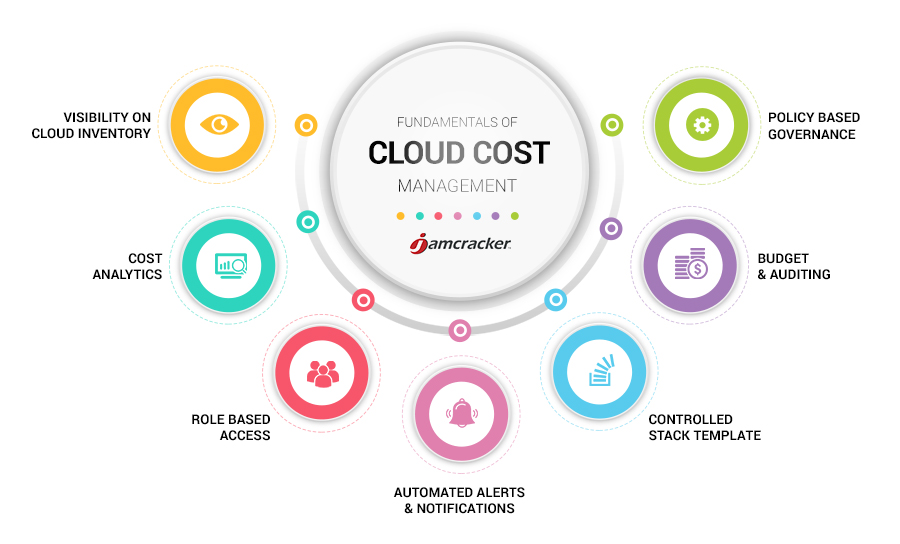
Fundamentals Of Cloud Cost Management
The overall goal of cost control and long-term cloud cost management in cloud computing like every other business is to optimize available financial resources, getting the most out of every corporate pound or dollar. Most people think that technology is the key to driving success in the cloud, but, in reality, it all comes down to controlling costs. Many IT teams find that their cloud costs grow less efficient as "clutter" builds up in their accounts.
For effective cost control in cloud computing services, it is quite important to understand the different factors that impact the cost and leverage cloud cost management tools to help discover the cause(s) of these inefficiencies. Unplanned costs are frequently the result of lack of visibility about the current consumption patterns and past trends, nonstandard deployments that come from unclear or absent development processes, poor organization, or the absence of automated deployment and configuration tools. By contrast with on-premise infrastructure, which is financed by fixed upfront investments, cloud consumption is an everyday operational expense. This requires a huge shift in your approach to operational management, where optimizing cost is as important as optimizing performance.

WAYS TO LOWER YOUR CLOUD COST
Visibility on Cloud Inventory
According to a recent survey of IT professionals, 75% report, they lack visibility of their cloud resources. This lack of visibility into resources in the cloud can lead to poor management of those resources. Effective management begins with an in-depth analysis of your entire infrastructure. And if some resources in the cloud are going unused due to lack of awareness, but the organization is still paying for them, costs will climb unnecessarily – and cut into the infrastructure savings and other financial benefits the cloud can bring. Admins who have access to a single pane of glass and detailed Resource Dashboards are equipped to better organize, manage, and optimize that ecosystem across all accounts, clouds, departments, and teams.
Cost Analytics
Complete visibility on the cloud services used, the actual usage patterns and trends is the first step. No matter your cloud environment, in addition to tracking what you have spent, it is important to project what you will be spending. You need consolidated as well granular details in the form of interactive graphical and tabular reports across multiple dimensions, time frames in a multi-cloud environmentto correlate data for analysis and reporting against business objectives.
Role Based Access
Permit users to actively manage the infrastructure after setting an Enterprise-wide mechanism that clearly defines permissions and accessibility within the platform. Limit the data and actions visible to users by organizations and roles and identify who launched, terminated, or changed infrastructure, and what they did to take corrective action and control costs.
Controlled Stack Templates
A crucial characteristic of any DevOps team is to enable teams more autonomy over-provisioning resources without the red tape and extensive time delay of traditional IT environments. If it is implemented without the accompanying automation and process best practices, decentralized teams have the potential to produce convoluted and non-standard security rules, configurations, storage volumes, etc. and therefore drive up costs. Using predefined stack templates, Administrators can bake in security, network, and instance family/size configurations, so that the process of deploying instances is not only faster but aligned with the Departmental user’s roles and privileges and ensures only specific Resources are provisioned.
Automated Alerts and Notifications
Stay on top of day-to-day changes in your environment, and participate in the critical decision by sharing standard and custom built reports with details on cost, usage, performance with stakeholders. Automated alerts and notifications about authorization failures, budget overruns, cost spikes, untagged infrastructure result in increased visibility and accountability.
Policy Based Governance
Use cloud-based governance tools to track cloud usage and costs and alert administrators when the total usage for the account is greater than a certain value or when the total usage for a vendor specific product is greater than a certain value helps control cost. Schedule operational hours to automatically shut down & start virtual machines, and automated events that alert administrators on volumes that have been disassociated from Virtual machines (standalone VMs) for more than a set number of days. Based on event thresholds, remove unused and underutilized resources and avoid unnecessary waste by sizing instances so they deliver a good balance between performance and cost. Avoid cost overrun by using policies to terminate servers created to temporarily handle the massive workloads.
In short, use integrated data sources, metadata, or custom tags to define a set of rules that lead to improved management, reporting and optimization.
Budgets
Define and allocate budgets for Departments, cost centers, projects and ensure approval mechanisms to avoid cost overrun by sending out alerts when thresholds are breached. Use the Showback report to chargeback Departments for their cloud usage and limit the cost and use of resources. This alignment of cost with value ensures the anticipated business benefit once the cloud resources are in production.




Leave a Comment